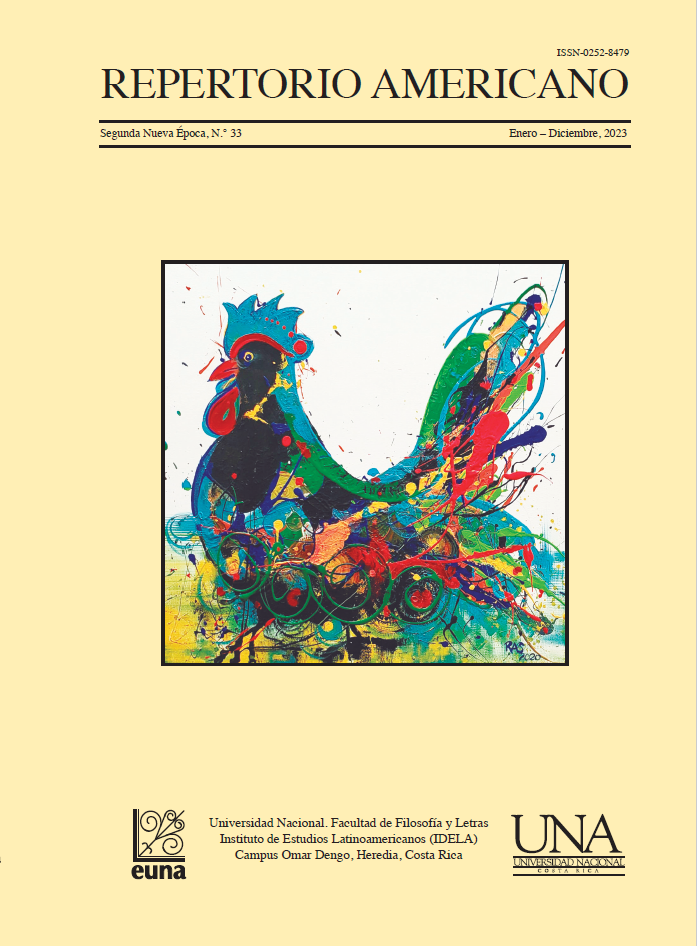Pixies and Sexuality: The (Literary) Analysis of the Lyrics of an Alternative Rock Band
DOI:
https://doi.org/10.15359/ra.1-33.5Keywords:
Literary analysis, song, poetry, music, popular music, PixiesAbstract
This study delves into the lyrics of three songs by the North American band Pixies. These lyrics explore the subject of sexuality, but they present a series of non-standard or traditionally unaccepted sexual practices related to sexual taboos, otherness, sexual objectification, sexual violence, and the body. Literary analysis is the approach used to examine the lyrics and the subjects explored by the band. Given that the central focus of the analysis is rock lyrics, which is a non-traditional subject of literary analysis, this study also addresses fundamental questions related to the nature of literature and literary expressions. In this sense, this article aims to demonstrate the value of rock lyrics as literary texts with a connection to poetry, both of which have music as the foundation of their form.
References
Astor, P. (2010). The Poetry of Rock: Song Lyrics Are Not Poems but the Words Still Matter; Another Look at Richard Goldstein’s Collection of Rock Lyrics. Popular Music, 29(1), 143–148. http://www.jstor.org/stable/40541482
Azlyrics.com. (2021, November 21). Kashmir Lyrics: Melpomene. https://www.azlyrics.com/lyrics/kashmir/melpomene.html
Azlyrics.com. (2021, September 14). Pixies Lyrics: Bone Machine. https:// www.azlyrics.com/lyrics/pixies/bonemachine.html
Azlyrics.com. (2021, September 14). Pixies Lyrics: Break my Body. https://www.azlyrics.com/lyrics/pixies/breakmybody.html
Azlyrics.com. (2021, September 14). PixiesLyrics: Broken Face. https://www.azlyrics.com/lyrics/pixies/brokenface.html
Azlyrics.com. (2021, November 21). PulpLyrics: Common People. https://www.azlyrics.com/lyrics/pulp/commonpeople.html
Barthes, R. (1970). Writing the DegreeZero. Beacon Press.
Brown, C. S. (1970). The Relations betweenMusic and Literature as aField of Study. Comparative Literature,22(2), 97–107. https://doi.org/10.2307/1769755
Cambridge Dictionary. (2022). Lovely.Cambridge Dictionary. https://dictionary.cambridge.org/dictionary/english/lovely
Cormany, D. L. (2015). Coachella Fans,Online and Translocal. Journalof Popular Music Studies (Wiley-Blackwell), 27(2), 184–198.https://doiorg.ezproxy.sibdi.ucr.ac.cr/10.1111/jpms.12120
Durbin, J. (2004). Listing. Maclean’s,117(15/16), 91.
Exposito, S. (2015). The Pixies’ Dark Triumph.Rolling Stone, 1227, 64.
Francis, B. (2016). Black Francis. RollingStone, 1273, 10.
Gibson, M. (2013). Pixies Part Ways WithBassist Kim Shattuck After OnlyThree Months. Time.Com, 1.
Green, B. (2016). ‘I Always Remember That Moment’: Peak Music Experiences as Epiphanies. Sociology,50(2), 333–348. https://www.jstor.org/stable/26556433
Greenblatt, L., Vozick-Levinson, S., Willman,C., Howe, S., Collis, C., Halperin,S., & Pastorek, W. (2008).DOOLITTLE. EntertainmentWeekly, 984, 16–17.
Greene, A. (2013). The Pixies (MinusDne) Keep Rolling. Rolling Stone,1194, 28.
Harris, K. (2016). Head Carrier. RollingStone, 1272, 51.
Hanna, J. (2010). Dance and Sexuality:Many Moves. Journal of Sex Research, 47(2/3), 212–241. https://doi-org.ezproxy.sibdi.ucr.ac.cr/10.1080/00224491003599744
Nicholls, D. (2007). Narrative Theory as an Analytical Tool in the Study of Popular Music Texts. Music & Letters,88(2), 297–315. http://www.jstor.org/stable/30163649
Novara, V. J., & Henry, S. (2009). A Guide to Essential American Indie Rock (1980-2005). Notes, 65(4), 816–833. http://www.jstor.org/ stable/27669942
R. S. (2013). The Pixies. Rolling Stone,1188, 72.
Račić, L. (1981). On the Aesthetics of Rock Music. International Review of the Aesthetics and Sociology of Music, 12(2), 199–202. https://doi.org/10.230 /836562
Sosa, E. (2009). La otredad: una visión del pensamiento latinoamericano contemporáneo.Letras, 51(80), 349-372. http://ve.scielo.or/scielo.php?script=sci_arttext& pid=S0459-12832009000300012&lng=es&tlng=es.
Tannenbaum, R. (2013). Pixies. Rolling Stone, 1192, 86.
Valdés Miyares, J. R. (2016). Breaking Joy Division’s “Glass”: Reading Song Lyrics as Literature. Atlantis,
(2), 161–180. http://www.jstor. org/stable/26330850
Vozick-Levinson, S. (2007). Pixies Update. Entertainment Weekly, 939, 77.
Wagner, C., & Stephan, E. (2005). Left of the Dial: An Introduction to
Underground Rock, 1980-2000. Music Reference Services Quarterly,
(4), 43–75. https://doi-org. ezproxy.sibdi.ucr.ac.cr/10.1300/j116v09n04_03
Wicke, P., & Deveson, R. (1982). Rock Music: A Musical-Aesthetic Study. Popular Music, 2, 219–243. https://www.jstor.org/stable/852983
Published
How to Cite
Issue
Section
License
Las cartas de entendimiento se facilitarán a las personas autoras al momento de aceptación de su trabajo para publicarse.
Todos los contenidos son de libre acceso con sólo citar la fuente.






